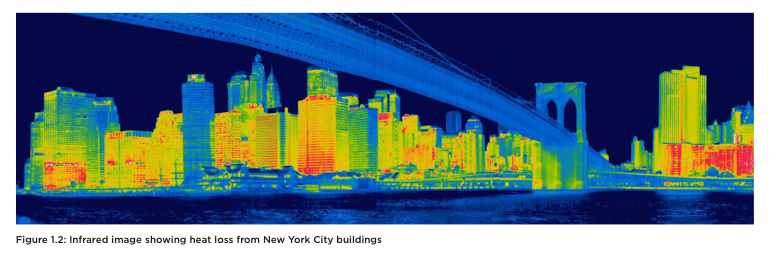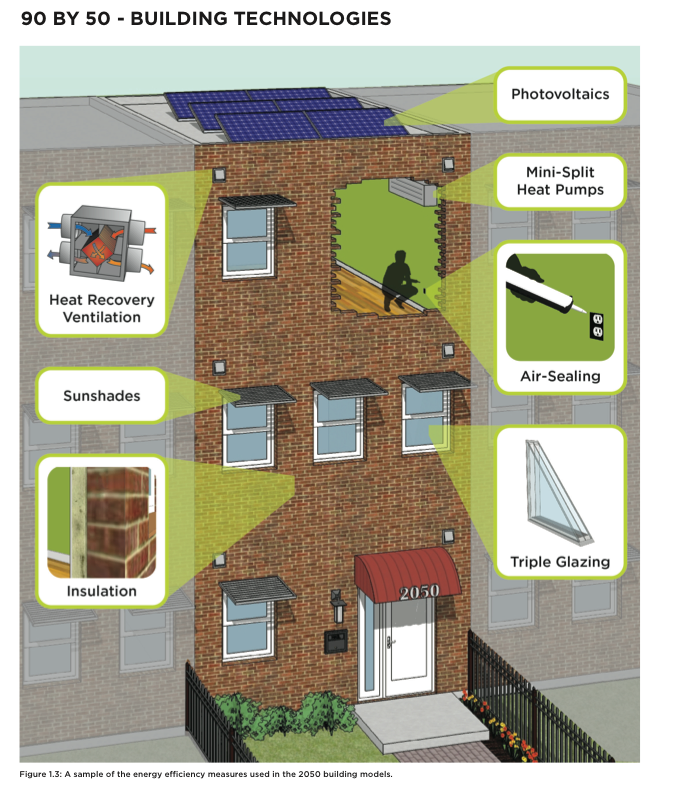URBAN GREEN COUNCIL
Introduction
Nearly all climate scientists tell us that to avoid catastrophic global warming we must dramatically reduce carbon emissions in the global economy by 2050. The devastation caused by hurricane Sandy has re-focused attention on both adapting to the threat posed by climate change and the necessity of acting to mitigate that threat.
For developed countries, emissions must be at least 80 percent below current (2010) levels by 2050 to permit convergence on a CO2 concentration likely to be less than 450 parts per million, which would in turn probably result in global temperature increases of less than 2°C (3.6°F). For New York City, a more challenging goal, a reduction of more than 80 percent, is appropriate for several reasons:
- The city’s greenhouse gas (GHG) accounting does not incude several important categories of emissions.
- New York City’s mass transportation system can attract even more passengers to carbon-free modes of travel.
- A 90 percent target leaves a little more “breathing room” if some reduction measures turn out to be impractical.
As a result, we have chosen a goal of reducing New York City’s greenhouse gas emissions by 90 percent by 2050. The year 2050 is 37 years away, and many political and economic shifts are possible during that period. Consequently, in determining the feasibility of this goal, we have focused on what is physically possible with presently available and reasonably foreseeable technology. We did not restrict our analysis by current political constraints, and gave only moderate attention to economic constraints.
A 90 percent cut in emissions does not correlate directly with a 90 percent cut in energy, since any energy need not met by fuels associated with the 10 percent residual emissions can be met by carbon-free electricity. This provides an additional constraint: After maximum energy reductions have been made, most fuel-based systems must be converted to electricity, since other energy sources cannot be made carbon-free. Rooftop photovoltaic panels were included in our models, but for the remaining supply side needs, we computed the required electrical energy and demand, while simply listing several options that could supply this carbon-free electricity.
We refer to “measures” rather than “proposals” to recognize that we are not recommending any particular steps, but are rather constructing one model scenario to show what is possible. Practical scenarios may differ dramatically in approach and in which specific reduction measures are actually implemented.
With the resources available, a detailed sector-by-sector study examining intermediate trajectories over the coming decades was not feasible. Instead, we examine the city as a whole, and look only at the two endpoints, 2010 and 2050. We believe this allows us to sketch a credible future that meets the “90 by 50” goal. It must, however, be seen as an initial effort, in need of significant refinement and expansion, before it can serve as a basis for specific policy proposals.
Where New York City Is Now
This study was restricted to sources and sectors included in the plaNYC report, “Inventory of New York City Greenhouse Gas Emissions” (Inventory). Because buildings are responsible for most of the city’s GHG emissions, they were the focus of our study, but emissions from several other sources are included as well.
The study started with a model of NYC buildings with which we reproduced current NYC GHG emissions within the building sector. We modeled the building sector using eight different building types representative of the building stock of the city, and used a widely accepted building simulation model (DOE-2) for each building type to estimate its particular current GHG emissions. Each model describes a well-defined building, the characteristics of which were selected to represent those of that building type across the entire city, as taken from the city’s tax lot and building database. Internal electric and fuel loads were apportioned using data from a recent Con Edison study of citywide energy use, the city’s benchmarking results, DOE-2 internal assumptions, and other standard sources.
The eight building types represented by our models are:
- One or two family detached house
- Three story row house
- Low rise apartment building
- Two high rise residential towers: Masonry with punch windows, Window wall
- Low rise commercial building
- Two high rise commercial towers: Masonry with punch windows, Curtain wall
We scaled these results up to assign emissions citywide stemming from each building type, using the ratio of the citywide floor area corresponding to that building type to the floor area in that model. Building types may be served by more than one fuel, so we allocated each building model across fuel types as part of the scaling process. After these parameters were applied, we also made various adjustments to building characteristics, so that in the end the building emissions scaled up from the 2010 models matched those from the Inventory, correctly allocating the emissions among building types. Building characteristics were also adjusted so that usage would match known fuel and electricity use data from the Inventory, the Con Edison study, New York City’s benchmarking data, and other sources.
Read full report (PDF) here: 90 by 50
About Urban Green Council
www.urbangreencouncil.org
“Urban Green Council is the New York Chapter of the U.S. Green Building Council (USGBC). Our mission is to lead in advancing the sustainability of urban buildings through education, advocacy and research. Recognizing that urban life leaves a smaller footprint than the suburban alternative, we envision cities that coexist in harmony with their natural environment and contribute to the health and well being of all.”
Tags: 2050, 90 by 50, 90%, carbon footprint, new york chapter, NYC, U.S. Green Building Council








 RSS Feed
RSS Feed